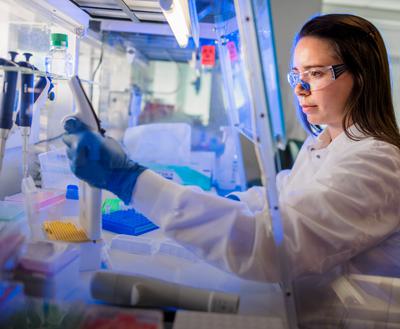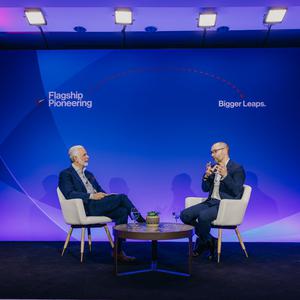From the moment we’re born, we become hosts for a multitude of viruses, which are thought to be the most diverse and abundant biological organisms on Earth. Some of these viruses have been harnessed to deliver payloads to patients, including adeno-associated viruses (AAVs), which have become a leading delivery mechanism for genetic therapies, among other applications. However, AAVs induce an immune response that causes side effects and prevents redosing of these medicines.
To overcome the limitations of established viral delivery technologies, Flagship Pioneering looked to other viruses that live in and among us that don’t cause disease. This led to the identification of anelloviruses as a broad class of ubiquitous, commensal viruses and the founding of Ring Therapeutics, a company developing first-in-class viral vectors based on these viruses. Our biology is so entwined with anelloviruses that Avak Kahvejian, Flagship General Partner and Founding CEO of Ring; Erica Weinstein, Flagship Principal and a member of Ring’s founding team; and Nathan Yozwiak, Ring’s Senior Director of Viral Genomics, hypothesized that “the ever-present episomal genomes of anelloviruses can be considered an extrachromosomal component of our own genetic makeup.”
While the extent of our relationship with anelloviruses is not yet fully understood, Ring has advanced the field considerably, building on early knowledge that anelloviruses were universally acquired in infancy and highly prevalent. Since its founding in 2017, Ring scientists have identified that anelloviruses are abundant in blood and extremely genetically diverse. They also determined that once acquired, anelloviruses appear to persist in the body and avoid clearance by the immune system, and evidence suggests they have broad tropism for different cells and tissue types, which could be an asset in delivering therapies throughout the body.
A major obstacle to studying anelloviruses, and thus adapting them for therapeutic applications, however, has been the inability to produce and/or propagate them. Ring has broken through this barrier, recently making available a preprint detailing their work to produce human anelloviruses in vitro. We spoke to Simon Delagrave, Ring’s SVP of Platform and Biology, to understand more about anelloviruses and Ring’s work at the forefront of this field.
If anelloviruses are common, why are they poorly understood and how does your work represent a breakthrough in understanding?
Scientists generally have less incentive to study viruses that are not pathogenic. For example, there is no need to study a virus and develop a vaccine against it if it doesn’t cause disease. Many of the most problematic viruses from a public health standpoint have been studied for decades. Moreover, these viruses were largely isolated from patients via cell culture, which is the same technology virologists use to produce and propagate viruses, as viruses need to use the machinery and metabolism of a host cell to replicate. Thus, for many viruses, virologists are able to easily identify the cells and conditions necessary for viral replication. Anelloviruses, on the other hand, were discovered using DNA-based methods, and later, next-generation sequencing methods opened our eyes to their presence in humans. Because of the genomics revolution, you don’t need cell culture methods to discover viruses, so solving the culturing problem comes later. As a result, a system did not yet exist to produce anelloviruses.
Being able to produce and/or propagate viruses is critical for research and development, which is partially why our work is such a breakthrough. We were able to get cells to make the virus when we gave them the anellovirus DNA, which has never been done before to our knowledge, and this breakthrough will enable us to learn much more about anelloviruses, including information about their replication, genome structure, and proteome. Foundational textbooks on virology that are thousands of pages long but only include a few pages on anelloviruses are going to need to be revised and expanded.







